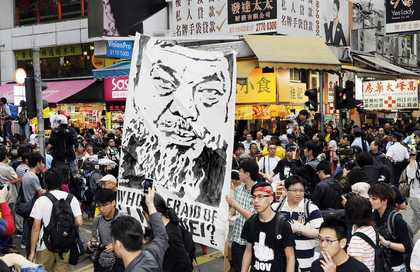
Artists march to demand the release of detained prominent Chinese artist Ai Weiwei, Hong Kong, 23 April 2011
Photo © Laurent Fievet / Getty Images
‘Democracy, material wealth, and universal education are the soil upon which modernism exists.’
– Ai Weiwei
Ai is right. Democracy is the basis for modern society. But does this mean that the art of modern society is also democratic? Can any good art be ‘democratic’? Art, like democracy, is about freedom of expression, open choice, and diversity of representation – surely art is the best expression of democracy?
It is in fact the other way around, as Ai would have to admit. Works of art are the least democratic objects of all. In his essay Art and Democracy, written in 1945 after years of promoting art to the public, Kenneth Clark came to the conclusion that art was ‘incurably aristocratic’, and (more controversially), ‘an outstanding example of the rule of the many by the few’. This is hardly wall text material for an art museum nowadays, but the point still stands: art is about an individual vision imposed on the world. No work of art worth looking at has ever been created by majority consensus. Artists are benign despots. Rather than a source of inspiration, democracy is, for artists, the worst possible situation to find themselves in.
Think, for example, of Joseph Beuys’s sculpture, Lightning with Stag in its Glare 1958–85 – a jagged, triangular shape around which are littered objects, like the petrified survivors of a sudden flash of illumination. The surrounding walls, posters and drawings elucidate Beuys’s idea that the free space of art is the perfect medium for direct democratic engagement and action. He pursued the cause relentlessly, establishing in 1972 the ‘Organisation for Direct Democracy through Referendum’, a notion that would not go down very well in the art world nowadays.
The problem is that, like his strange aluminium stag, his explanatory blackboard diagrams seem largely incomprehensible, and his authoritarian, mystical approach hardly conducive to the type of exchange that might truly constitute a model of direct democracy. Beuys, perhaps unconsciously, brought out the paradox of democracy: that it by no means ensures intelligent, or intelligible, representation. Nor can it ensure good art – as Alexis de Tocqueville recognised in one of the greatest books about democracy ever written, Democracy in America 1835. He wrote of the drive in democratic societies towards cheapness and utility, making the production of great art an exception, and concluded that ‘in aristocracies a few great pictures are produced; in democratic countries a vast number of insignificant ones’.
That art is not democratic is the reason that art museums can be. They are, I think, our most important democratic institutions in that they bridge the gap between the benevolent dictatorship of art and a wider, democratic society. It is hardly an easy task, particularly at a time when democracy seems itself to have become as strange as the most obscure works of art.
If, in a divided society, ‘more and better free speech’ is the common ground we must establish, as Timothy Garton Ash writes in his recent book Free Speech: Ten Principles for a Connected World, then art museums must play a central role.
But ‘free speech’ is not just a matter of liberal tolerance, but also of reflecting those parts of our society that seem strange and difficult from a liberal point of view. ‘More and better free speech’ must include the incomprehension and anger that still often greets the benignly despotic products of contemporary artists. An art museum should not be rule-bound or didactic, like a school, but open like a public square.
As the historian Tony Judt once observed, the best way to defend such vast, impersonal abstractions as democracy is to support those institutions that ‘incarnate our best attempt at those large abstractions’. And, at their finest, this is what museums must do: embody democracy in all its strangeness and paradox.
John-Paul Stonard is a writer and an art historian. He is currently writing a book about the story of art for Bloomsbury.
